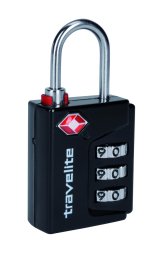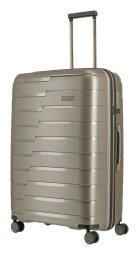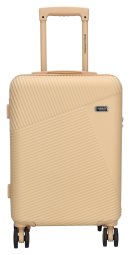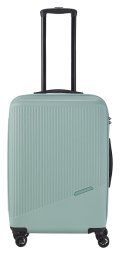Travel is synonymous with discovery, adventure, and relaxation. Whether you're heading for a seaside holiday, a sightseeing tour of world capitals, or an important business trip, the last thing you want to deal with is luggage problems. The thought of finding your suitcase damaged or with a broken lock upon arrival can spoil the mood of even the greatest optimist. That's precisely why a smart solution exists, one that has become the standard for modern travelers – the TSA lock.
In this comprehensive guide, we will delve into the world of TSA locks. We'll explain what TSA means, how these locks work, why they are so crucial for air travel, and how they can save you a lot of hassle and money. You will also learn about the different types that exist and what to look out for when choosing one. With us, you'll be perfectly prepared for your next journey.
Contents:
- What are TSA locks and how do they work?
- Why is a TSA lock a necessity?
- How to set a TSA lock?
- Types of TSA Locks: Integrated vs. Padlock
- Frequently Asked Questions (FAQ)
- Travel Smart, Safe, and Worry-Free
What are TSA locks and how do they work? The secret of the red diamond
The acronym TSA stands for Transportation Security Administration. It is a U.S. government agency created after the events of September 11, 2001, to enhance security at American airports and in transportation in general. One of its main tasks is the physical inspection of checked baggage to ensure it does not contain dangerous or prohibited items.
And this is where the TSA lock comes in. It is a special type of lock (either integrated directly into the suitcase or as a separate padlock) that TSA security officers can open without causing damage. How? They have a master key that fits every certified TSA lock.
How does it work in practice?
- You lock your luggage using your own combination of a numerical code. Only you know your numerical code.
- If your luggage is selected for a random inspection at the airport, security officers do not need to pry or cut the lock.
- Using the master key, they simply and safely open your TSA lock.
- After conducting the inspection, they lock the luggage again and send it on its way.
- Your suitcase and its contents remain safe and without any damage.
- You can recognize every certified TSA lock by its special logo – a small red diamond with the inscription "Travel Sentry Approved". It is this logo that signals to airport security that they can use their master key.
Why is a TSA lock on a suitcase a necessity for air travel?
You might think that if you are not traveling directly to the United States, you don't need a TSA lock. The opposite is true. The TSA lock system has been gradually adopted by many other countries around the world, including Canada, Australia, Japan, Israel, South Korea, Finland, and many others. Airport security in these locations is also equipped with the necessary keys.
Using a non-TSA lock on your suitcase carries a risk. If your luggage is selected for inspection and airport staff cannot open it, they have the right to forcibly remove the lock. In practice, this means a cut padlock or, in a worse case, a broken or damaged integrated lock and zipper. Not only do you lose the lock, but your suitcase remains unlocked for the rest of the journey and vulnerable to theft. A suitcase with a TSA lock saves you from these worries.
| Benefits of using a TSA lock | Risks without a TSA lock |
|---|---|
| Security officers open the lock without damage. | Forcible opening and destruction of the lock and suitcase. |
| Your luggage remains securely locked after inspection. | The suitcase remains unlocked for the rest of the journey. |
| Peace of mind and protection of your investment in a quality suitcase. | Stress, potential costs for repair or a new suitcase. |
| A globally recognized standard. | Complications at many international airports. |
How to set a TSA lock?
Setting your own code correctly is key to using the lock securely. Fortunately, the process is simple and takes only a few moments. For most locks, the default code is 0-0-0, and to set your own combination, you just need to press the reset button.
Because the procedures for different types of locks (integrated, padlocks) vary slightly, we have prepared a detailed step-by-step guide for you, including instructional videos.
>> Go to the detailed guide: How to set a TSA lock (including videos) <<
Types of TSA Locks: Integrated vs. Padlock
You'll find two main types of TSA locks on the market. Each has its advantages and is suitable for different situations.
- Suitcases with integrated TSA locks: The lock is a fixed part of the suitcase's construction. This is an elegant and practical solution because you can't lose the lock. You will most often find it on hardshell suitcases with a TSA lock, but also on high-quality soft-shell models. The zipper pulls click into this type of lock.
- TSA padlock: A separate lock that you can use on any luggage with zipper loops – a suitcase, a travel backpack, a travel bag. It is flexible and you can move it between bags. There are versions with a key and with a numerical code. A TSA combination padlock is a great choice if your current suitcase does not have a TSA-type lock.
Frequently Asked Questions (FAQ)
- Where else besides the USA are checks performed using a TSA key?
Besides the USA, the system is used by numerous other airports, for example in Canada, Australia, New Zealand, Japan, Israel, South Korea, Finland, Germany, Austria, Belgium, the Netherlands, Switzerland, the Czech Republic (Václav Havel Airport Prague), and others. Their number is constantly growing. - What is an opening indicator?
Some modern TSA locks have a small indicator (usually a green or red dot) that appears after the lock has been opened with a master key. This lets you know immediately upon collecting your luggage that it has been inspected. You can then easily reset the indicator when you open the lock with your code. - My TSA lock doesn't have a combination dial but locks with a key. Does it work the same?
Yes, it works exactly the same. Some TSA padlocks operate with a traditional key. The principle remains the same – you lock and unlock with your key, airport staff with their master key. Just be careful not to lose your key! - What is the best way to label a suitcase for air travel?
Labeling your suitcase is another important security step, in addition to the lock. Always place a tag with your name and contact details on your suitcase. Even if you have luggage with a TSA lock, this label helps in case of loss or mix-up.
Travel Smart, Safe, and Worry-Free
Investing in a suitcase with a TSA lock or purchasing a separate TSA padlock is one of the easiest and most effective ways to ensure peaceful travel. It protects your luggage from damage during necessary security checks while keeping its contents safe.
Remember that a TSA lock is not just about traveling to America, but a global standard that makes your movement through airports worldwide easier. No more fear of broken locks and damaged suitcases. Choose from our wide range of suitcases with integrated TSA locks or get a flexible TSA padlock and enjoy your journey to the fullest without unnecessary complications.












